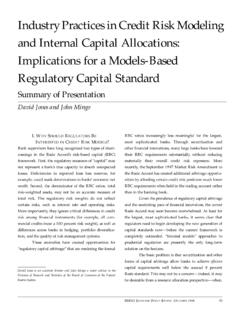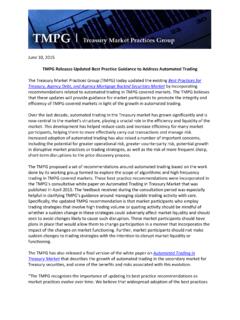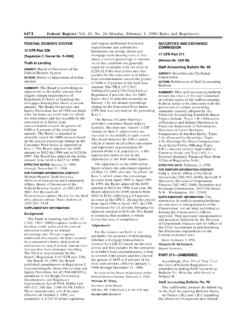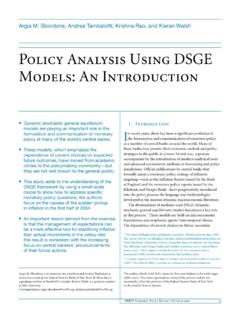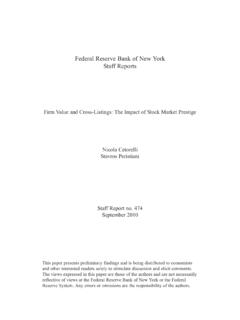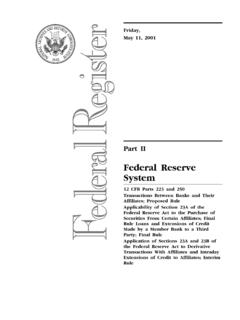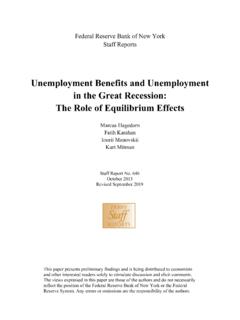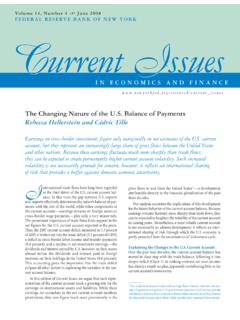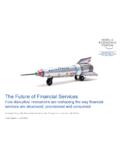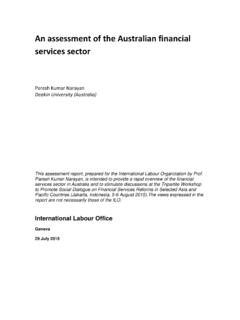Transcription of The Consolidation of the Financial Services Industry ...
1 The Consolidation of the Financial Services Industry :Causes, Consequences, and Implications for the Future Allen N. BergerBoard of Governors of the Federal Reserve SystemWashington, DC 20551 Financial Institutions CenterPhiladelphia, PA 19104 S. DemsetzFederal Reserve Bank of New York New York, NY 10045 Philip E. StrahanFederal Reserve Bank of New York New York, NY 10045 Forthcoming,Journal of Banking and FinanceVolume 23, 1999 AbstractThis article designs a framework for evaluating the causes, consequences, and future implications of financialservices Industry Consolidation , reviews the extant research literature within the context of this framework (over250 references), and suggests fruitful avenues for future research.
2 The evidence is consistent with increases inmarket power from some types of Consolidation ; improvements in profit efficiency and diversification of risks,but little or no cost efficiency improvements on average; relatively little effect on the availability of Services tosmall customers; potential improvements in payments system efficiency; and potential costs on the financialsystem from increasing systemic risk or expanding the Financial safety classification codes: G21, G28, G34, E58, L89 Key words: Banks, Mergers, Payments, Small business The opinions expressed do not necessarily reflect those of the Federal Reserve Board, the New York ReserveBank, or their staffs.
3 We thank Bob Avery, Seth Bonime, Raphael Bostic, Steve Cecchetti, Dan Covitz, DaveCummins, Bob DeYoung, Jeanette Donato, Diana Hancock, Tim Hannan, Iftekar Hasan, Dave Humphrey, MyronKwast, Susan Leadem, Jamie McAndrews, Loretta Mester, Rick Mishkin, Linda Pitts, Matthew Porter, RobinPrager, Larry Radecki, Steve Rhoades, Tony Saunders, Greg Udell, Barbara Walter, and Eliza Wright for helpwith the address correspondence to Philip E. Strahan, Federal Reserve Bank of New York, 33 Liberty Street, NewYork, NY 10045, or email IntroductionThe Financial Services Industry is consolidating around the globe.
4 Mergers and acquisitions (M&As)among Financial institutions are occurring at a torrid pace in the , may occur at a rapid pace in the near futurein Europe under monetary union, and may be part of the solution to problems of Financial distress in Asia andelsewhere. Moreover, we may be on the brink of a new wave of M&As between large banking organizations andother types of Financial service providers there has been considerable research on Financial Services Industry Consolidation , much is yet tobe understood. The main purposes of this article are to design a framework or model for evaluating the causes,consequences, and future implications of Financial Services Industry Consolidation , review the extant researchliterature within the context of this framework (over 250 references), and suggest fruitful avenues for our framework, the main motivation behind Consolidation is to maximize shareholder value, althoughwe also consider the motives of other stakeholders, particularly managers and governments.
5 Value may bemaximized through M&As primarily by increasing the participating firms market power in setting prices or byimproving their efficiency, and in some cases by increasing their access to the safety framework predicts that the pace of Consolidation will primarily be determined by changes ineconomic environments that alter the constraints faced by Financial service firms. We identify five such changesthat may be partially responsible for the recent rapid pace of Consolidation technological progress,improvements in Financial condition, excess capacity or Financial distress in the Industry or market, internationalconsolidation of markets, and deregulation of geographical or product consequences of Consolidation include not only the direct effects of increased market power orimproved firm efficiency, but also some indirect effects.
6 One potential indirect consequence may be a reductionin the availability of Financial Services to small customers. Potential systemic consequences of consolidationinclude changes in the efficiency of the payments system and changes in the safety and soundness of the financialsystem. In principle, policy makers may balance the expected social benefits and costs of these consequencesin setting rules on Consolidation or in approving/disapproving individual M&As. In practice, however, it maybe difficult to quantify these benefits and framework divides the research literature on the consequences of Consolidation into two logically2separable categories static analyses and dynamic analyses.
7 Static analyses are defined here to be studies thatrelate the potential consequences of Consolidation to certain characteristics of Financial institutions that areassociated with Consolidation , such as institution size. However, static studies do not use data on M&As. Theseanalyses are not necessarily intended to provide information about the effects of Consolidation , but theynonetheless may prove useful in predicting the consequences of M&As. For example, static analyses of scaleefficiency may give valuable information as to the efficiency effects of M&As in which the institutionssubstantially increase their analyses are defined here to be studies that compare the behavior of Financial institutions beforeand after M&As or compare the behavior of recently consolidated institutions with other institutions that havenot recently engaged in M&As.
8 Dynamic analyses take into account that M&As are dynamic events that mayinvolve changes in organizational focus or managerial behavior. These analyses also incorporate any short-termcosts of consummating the M&A (legal expenses, consultant fees, severance pay, etc.) or disruptions due todownsizing, meshing of corporate cultures, or turf battles. Dynamic analyses are more inclusive than staticanalyses. For example, dynamic analyses of the efficiency consequences of Consolidation include changes in X-efficiency (distance from optimal point on the best-practice efficient frontier) as well as the changes in scale,scope, and product mix efficiencies included in static framework also emphasizes the importance of considering the external effects of Consolidation ,defined here as the reactions of other Financial service providers to M&As in their markets.
9 The changes incompetitive conditions created by M&As may evoke significant reactions by rival firms in terms of their ownorganizational focus or managerial behavior that may either augment or offset the actions of the consolidatingfirms. For example, if consolidating institutions reduce their availability of credit to some small businesses, otherinstitutions may pick up some of the dropped small business credits if it is value maximizing for them to do by including the external effects can the total effects of Consolidation be 2 presents some facts of Consolidation summary statistics that provide backgroundinformation for the discussion that follows.
10 Section 3 reviews the causes of Financial Consolidation and identifieschanges in the economic environment that may affect the pace of Consolidation . Sections 4, 5, and 6 review theresearch literature on three potential consequences of Consolidation changes in market power, efficiency, and3the availability of Services to small customers, respectively. Section 7 addresses two potential systemicconsequences of Consolidation , changes in payments system efficiency and Financial system safety and 8 extrapolates from the extant research to draw implications for future Consolidation and for The facts of Financial consolidationTables 1-5 report aggregate statistics on trends in Financial Consolidation .
